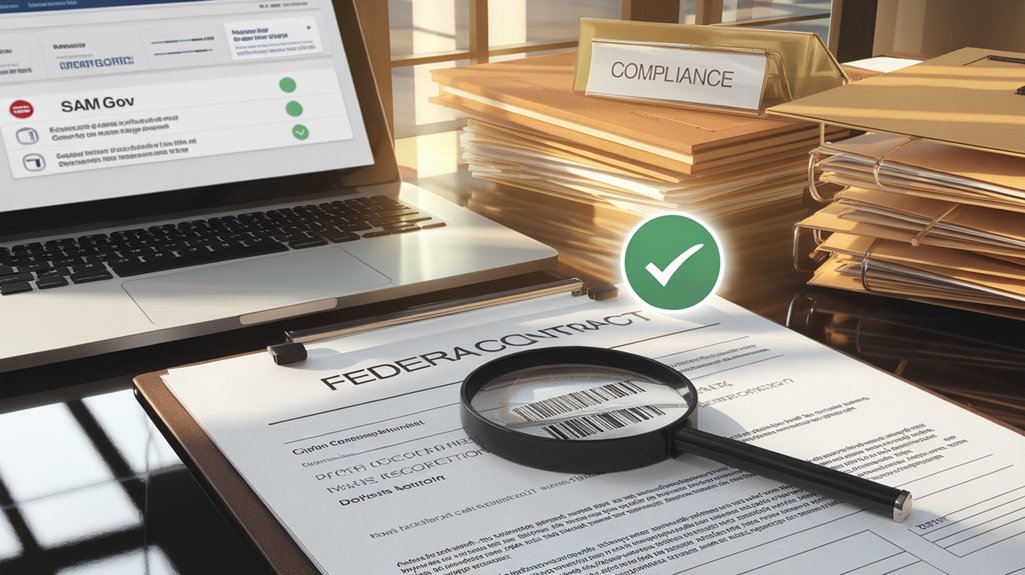CAGE code errors in SAM typically stem from IRS mismatches, documentation gaps, or address verification failures. To resolve these issues, verify business information against official records, contact the DLA CAGE office at 1-877-352-2255, and submit proper documentation like utility bills. Implement quarterly reviews of CAGE information and establish clear management responsibilities to prevent future problems. Creating a verification checklist helps staff avoid common validation pitfalls that can disrupt federal contracting opportunities.
Common CAGE Code Validation Failures in SAM

When registering in the System for Award Management (SAM), businesses frequently encounter validation failures related to their Commercial and Government Entity (CAGE) codes.
These validation obstacles typically fall into several distinct categories.
IRS mismatches represent a significant hurdle, occurring when taxpayer information doesn’t exactly match IRS records or when EIN-linked contacts lack proper authorization.
Taxpayer information discrepancies and unauthorized EIN contacts create critical validation barriers during CAGE code processing.
Documentation gaps, including missing utility bills or unnotarized entity paperwork, often trigger rejection under current verification standards.
Administrative errors compound these challenges, particularly when registrants mislabel CAGE codes as “SAM numbers” or allow registrations to lapse without renewal.
Data-entry mistakes in critical fields can cascade into persistent validation problems.
Physical address verification failures are increasingly common due to the stricter validation rules implemented by the Defense Logistics Agency.
PO boxes and mail forwarding services are automatically rejected as invalid physical addresses when applying for a CAGE code.
Systemic issues also contribute to failures, with SAM-DLA synchronization delays creating false mismatches and legacy CAGE codes conflicting with new submissions.
Maintaining accurate documentation throughout the registration process is essential for avoiding unnecessary delays in government contracting opportunities.
Restricted DLA support hours further complicate timely troubleshooting for businesses facing validation roadblocks.
Step-by-Step Solutions for Address Duplicate Errors

Resolving address duplicate errors in the CAGE code validation process requires a systematic approach to identify and correct the underlying issues. When the Defense Logistics Agency (DLA) system flags an address as already registered with another CAGE code, entities must take immediate action to guarantee registration accuracy.
First, verify all business information entered in the SAM registration matches official records. Next, contact the DLA CAGE Code office at 1-877-352-2255 for assistance with address verification and to determine which existing registration contains the duplicate address. The DLA can help identify discrepancies and recommend appropriate corrections. Entities can also reach out via email at dlacontactcenter@dla.mil for CAGE validation failures that require resolution.
Entities should also review any email notifications from SAM regarding validation failures, as these contain specific details about the duplicate issue. Documentation such as utility bills can serve as evidence to verify your business address when resolving duplicate issues. Applicants should be prepared for potential waiting periods during the validation process while issues are being resolved.
Once identified, update the registration information with the correct address details, guaranteeing it’s unique within the system to successfully complete the CAGE code validation process.
Preventing Future CAGE Code Issues in Government Contracting

Proactive management of Commercial and Government Entity (CAGE) codes represents a critical foundation for successful government contracting relationships. By implementing best practices for error prevention, contractors can maintain compliance and avoid costly delays in the procurement process.
Regular validation of business information in the System for Award Management (SAM) guarantees consistency across all government platforms.
- Maintain data synchronization by conducting quarterly reviews of your CAGE code information, verifying that business details match exactly across SAM and other government systems.
- Develop internal policies that clearly outline responsibilities for CAGE code management, including designated personnel for updates and monitoring.
- Implement a verification checklist that staff must complete before submitting any changes to government registration systems.
Addressing common validation issues promptly can prevent disruptions in your ability to secure federal contracts.
Remember that CAGE codes expire every five years and require renewal through your SAM registration to maintain eligibility for federal contracts.
Establishing thorough training programs for staff handling government registrations ultimately reduces errors and streamlines operations, creating a more efficient contracting experience for all parties involved. Utilize resources from CAGE Public features to access instructional materials and frequently asked questions for proper code maintenance.
Frequently Asked Questions
How Long Does CAGE Code Validation Typically Take?
The CAGE code validation process typically takes 10-15 business days for standard applications that undergo external reviews.
Automatic assignment occurs during SAM registration for U.S. entities without existing codes.
However, validation can experience significant delays when applications trigger manual reviews due to data discrepancies, incorrect documentation, or IRS validation errors.
For best processing, entities should verify all information against IRS records before submission and allow 2+ months before needing the code for procurement activities.
Can I Expedite My CAGE Code Resolution Process?
Yes, CAGE code resolution can be expedited in special circumstances. Entities can request expedited processing by indicating urgency during application or by contacting the Defense Logistics Agency (DLA) directly.
Emergency situations, such as disaster response contracts, typically qualify for expedited handling. The process requires proper documentation, including potentially DOD Form 2051 for security clearance cases.
While expedited, verification steps remain thorough to guarantee accuracy, with manual processing handled by DLA staff.
Do International Contractors Need CAGE Codes or NATO Codes?
International contractors need NCAGE codes, not CAGE codes. NCAGE codes are specifically designed for entities located outside the United States and its territories, while CAGE codes are reserved for domestic contractors.
International contractors must obtain an NCAGE code through the NATO ePortal before completing SAM registration. Unlike CAGE codes which expire every five years, NCAGE codes do not have expiration dates.
Both codes serve similar functions in enabling participation in government contracts.
What Happens if My Business Relocates After CAGE Validation?
When a business relocates after CAGE validation, the CAGE code itself remains unchanged, but the company must update its business address in the System for Award Management (SAM).
Business address changes should be submitted promptly to maintain compliance with government contractual obligations.
Failure to update location information can trigger verification issues and potentially jeopardize contract eligibility.
Companies should verify all contact details are current in SAM following any relocation to guarantee continued validity of their CAGE code registration.
Are CAGE Codes Required for Subcontractors Working With Prime Contractors?
Subcontractor requirements for CAGE codes vary based on contract specifics.
While not universally mandatory, many prime contractor responsibilities include requiring subcontractors to obtain CAGE codes for tracking and compliance purposes.
Subcontractors handling classified information (under clause 52.204-2) must have CAGE codes.
Though technically optional in some cases, having a CAGE code facilitates collaboration with primes and enhances visibility in federal contracting databases, making it a practical business necessity for most subcontractors.